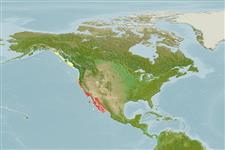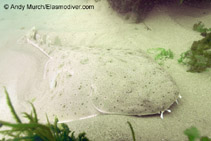Squatina californica Ayres, 1859
Pacific angelshark
Add your observation in Fish Watcher
| Native range | All suitable habitat | Point map | Year 2050 |

|
| This map was computer-generated and has not yet been reviewed. |
| Squatina californica AquaMaps Data sources: GBIF OBIS |
Upload your photos and videos
Pictures | Google imageSquatina californica
Picture by Murch, A.
Pictures | Google imageSquatina californica
Picture by Murch, A.
Mexico country information
Common names:
Angelote, Angelote del Pacífico, Tiburón angel
Occurrence: native
Salinity: marine
Abundance: | Ref:
Importance: | Ref:
Aquaculture: | Ref:
Regulations: | Ref:
Uses: no uses
Comments: Bahai Magdalena, southern Baja California (Ref. 96339). Also Ref. 128973.
National Checklist:
Country Information: https://www.cia.gov/library/publications/resources/the-world-factbook/geos/mx.html
National Fisheries Authority:
Occurrences: Occurrences Point map
Main Ref: Love, M.S., C.W. Mecklenburg, T.A. Mecklenburg and L.K. Thorsteinson, 2005
National Database:
Occurrence: native
Salinity: marine
Abundance: | Ref:
Importance: | Ref:
Aquaculture: | Ref:
Regulations: | Ref:
Uses: no uses
Comments: Bahai Magdalena, southern Baja California (Ref. 96339). Also Ref. 128973.
National Checklist:
Country Information: https://www.cia.gov/library/publications/resources/the-world-factbook/geos/mx.html
National Fisheries Authority:
Occurrences: Occurrences Point map
Main Ref: Love, M.S., C.W. Mecklenburg, T.A. Mecklenburg and L.K. Thorsteinson, 2005
National Database:
Common names from other countries
Classification / Names Nombres comunes | Sinónimos | Catalog of Fishes(Género, Especie) | ITIS | CoL | WoRMS | Cloffa
Elasmobranquios (tiburones y rayas) (sharks and rays) > Squatiniformes (Angel sharks) > Squatinidae (Angel sharks)
Etymology: Squatina: Latin for skate, which angel sharks superficially resemble, presumably tautonymous with Squalus squatina Linnaeus 1758 (no species mentioned) (See ETYFish); californica: -ica (L.), belonging to: California (USA), referring to type locality in San Francisco Bay (See ETYFish).
More on author: Ayres.
Etymology: Squatina: Latin for skate, which angel sharks superficially resemble, presumably tautonymous with Squalus squatina Linnaeus 1758 (no species mentioned) (See ETYFish); californica: -ica (L.), belonging to: California (USA), referring to type locality in San Francisco Bay (See ETYFish).
More on author: Ayres.
Issue
It is sympatric with S. armata.
Environment: milieu / climate zone / depth range / distribution range Ecología
marino demersal; rango de profundidad 3 - 205 m (Ref. 9253), usually 3 - 46 m (Ref. 54903). Subtropical; 52°N - 7°N, 130°W - 77°W
Distribución Países | Áreas FAO | Ecosistemas | Ocurrencias, apariciones | Point map | Introducciones | Faunafri
Eastern Pacific: Canada to Gulf of California, south to Panama.
Length at first maturity / Tamaño / Peso / Age
Maturity: Lm 97.0, range 86 - 108 cm
Max length : 152 cm TL macho / no sexado; (Ref. 247); edad máxima reportada: 35 años (Ref. 6147)
Max length : 152 cm TL macho / no sexado; (Ref. 247); edad máxima reportada: 35 años (Ref. 6147)
Short description Claves de identificación | Morfología | Morfometría
Espinas dorsales (total) : 0; Espinas anales: 0.
Found on the continental shelf and littoral areas (Ref. 247).A sluggish and inactive species that buries itself in sand or mud (Ref. 247). Also found around rocks, heads of submarine canyons, and sometimes near kelp forests (Ref. 247). Feeds on bottom and epibenthic fishes, including croakers, California halibut, and squid (Ref. 247). Ovoviviparous (Ref. 50449). Can whip up its head and snap very quickly when touched, provoked, harassed, or speared, and can inflict painful lacerations (Ref. 247).
Life cycle and mating behavior Madurez | Reproducción | Puesta | Huevos | Fecundidad | Larva
Ovoviviparous, embryos feed solely on yolk (Ref. 50449).
Main reference
Upload your references | Referencias | Coordinador : Compagno, Leonard J.V. | Colaboradores
Compagno, L.J.V., 1984. FAO Species Catalogue. Vol. 4. Sharks of the world. An annotated and illustrated catalogue of shark species known to date. Part 1 - Hexanchiformes to Lamniformes. FAO Fish. Synop. 125(4/1):1-249. Rome, FAO. (Ref. 247)
IUCN Red List Status (Ref. 130435: Version 2024-2)
Near Threatened (NT) ; Date assessed: 03 December 2014
Human uses
Pesquerías: comercial
FAO(pesquerías: producción, species profile; publication : search) | FishSource | Sea Around Us
Más información
Trophic ecology
componentes alimenticios
Composición de la dieta
consumo de alimento
Food rations
Despredadores
componentes alimenticios
Composición de la dieta
consumo de alimento
Food rations
Despredadores
Population dynamics
Coeficiente del crecimiento para
Max. ages / sizes
Length-weight rel.
Length-length rel.
Length-frequencies
Mass conversion
Reclutamiento
Abundancia
Coeficiente del crecimiento para
Max. ages / sizes
Length-weight rel.
Length-length rel.
Length-frequencies
Mass conversion
Reclutamiento
Abundancia
Life cycle
Reproducción
Madurez
Fecundidad
Puesta
Spawning aggregations
Huevos
Egg development
Larva
Dinámica larvaria
Reproducción
Madurez
Fecundidad
Puesta
Spawning aggregations
Huevos
Egg development
Larva
Dinámica larvaria
Anatomy
Superficie branquial
Brain
Otolith
Superficie branquial
Brain
Otolith
Physiology
Body composition
Nutrients
Consumo del oxígeno
Tipo de natación
Velocidad de natación
Visual pigments
Fish sound
Diseases & Parasites
Toxicity (LC50s)
Body composition
Nutrients
Consumo del oxígeno
Tipo de natación
Velocidad de natación
Visual pigments
Fish sound
Diseases & Parasites
Toxicity (LC50s)
Human related
Aquaculture systems
Perfiles de acuicultura
Razas
Ciguatera cases
Stamps, coins, misc.
Aquaculture systems
Perfiles de acuicultura
Razas
Ciguatera cases
Stamps, coins, misc.
Herramientas
Bio-Quiz | E-book | Guía de campo | Asistente para frecuencias de tallas | Herramienta de ciclo de vida | Mapa de puntos | Classification Tree
| Catch-MSY |
Special reports
Download XML
Fuentes de Internet
Aquatic Commons | BHL | Cloffa | Websites from users | Check FishWatcher | CISTI | Catalog of Fishes(Género, Especie) | DiscoverLife | ECOTOX | Faunafri | Fishtrace | GenBank(genome, nucleotide) | GloBI | GOBASE | | Google Books | Google Scholar | Google | IGFA World Record | MitoFish | Otolith Atlas of Taiwan Fishes | PubMed | Reef Life Survey | Scirus | SeaLifeBase | Árbol de la vida | Wikipedia(Go, búsqueda) | World Records Freshwater Fishing | Zoobank | Expediente Zoológico
Estimates based on models
Preferred temperature (Ref. 115969): 12.5 - 25.9, mean 21 (based on 60 cells).
Phylogenetic diversity index (Ref. 82804): PD50 = 0.5000 [Uniqueness, from 0.5 = low to 2.0 = high].
Bayesian length-weight: a=0.00676 (0.00295 - 0.01551), b=3.07 (2.88 - 3.26), in cm Total Length, based on LWR estimates for this Genus-body shape (Ref. 93245).
Nivel trófico (Ref. 69278): 4.1 ±0.4 se; based on diet studies.
Resiliencia (Ref. 120179): Muy bajo, población duplicada en un tiempo mínimo superior a 14 años (K=0.15-0.16; tm=8-13; tmax=35; Fec=6).
Fishing Vulnerability (Ref. 59153): High to very high vulnerability (67 of 100).




